This post may contain affiliate links. We may receive a small commission, at no cost to you, if you make a purchase. Read Disclosure.
I loved our history and street food tour of Rome because of the insights it gave me into Italian food – one of my favorite cuisines in the world. Firstly, I had it all wrong.
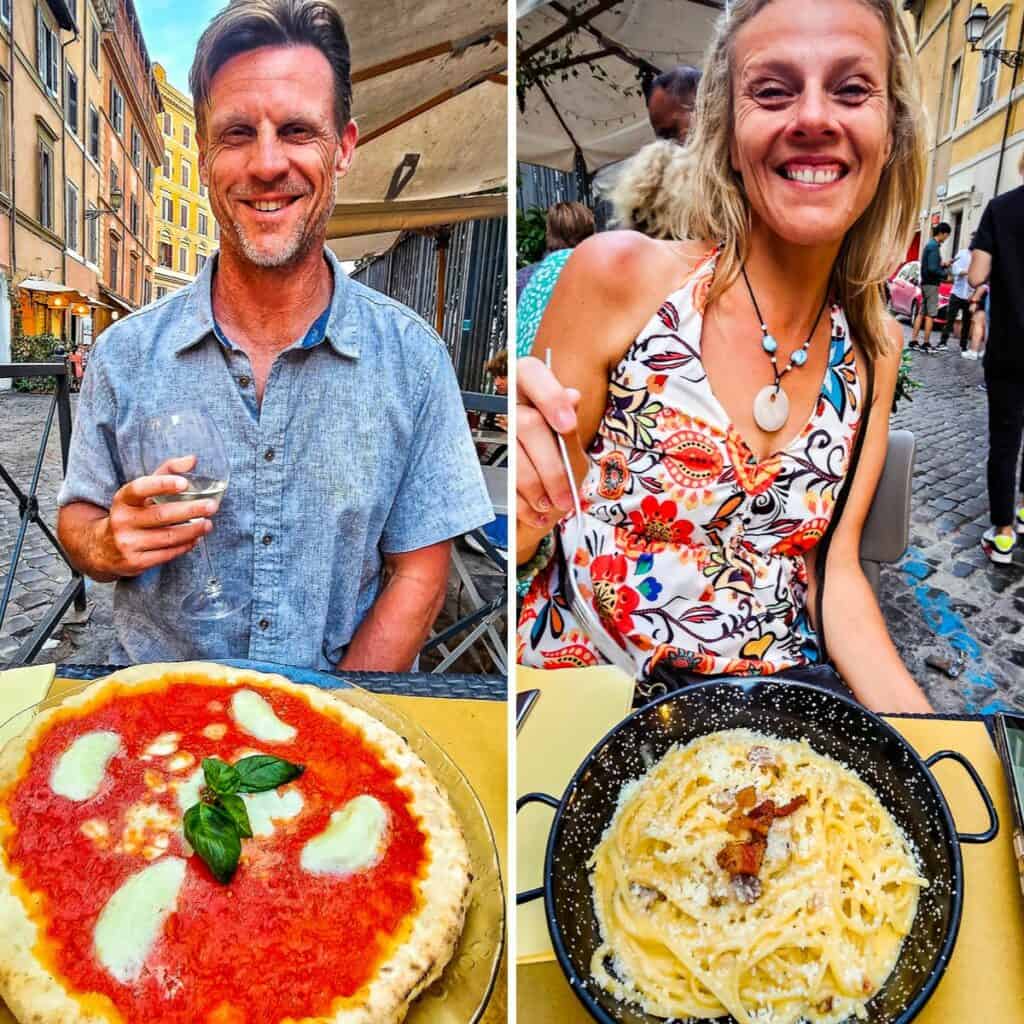
There is no standard Italian cuisine, instead the food of Italy is made up of many regional dishes, and there is so much more than just pizza, pasta and gelato.
Before the unification in 1861, Italy was separate regions like Tuscany and Puglia that had their own iconic dishes and style of eating.
So rather than national Italian dishes, you’ll find specific food in each region like lasagna in Bologna, and meat and bread from Tuscany (no traditional pasta) and round pizza in Napoli, with square ones in Rome. (That doesn’t mean you won’t find your Italian favorites across Italy!)
You see, you learn so much on a Rome food tour! But if you’re not sure what to expect or whether a food tour in Rome is worth it, here is a complete guide based on our personal experience.
About A Rome Street Food Tour: The Local Perspective
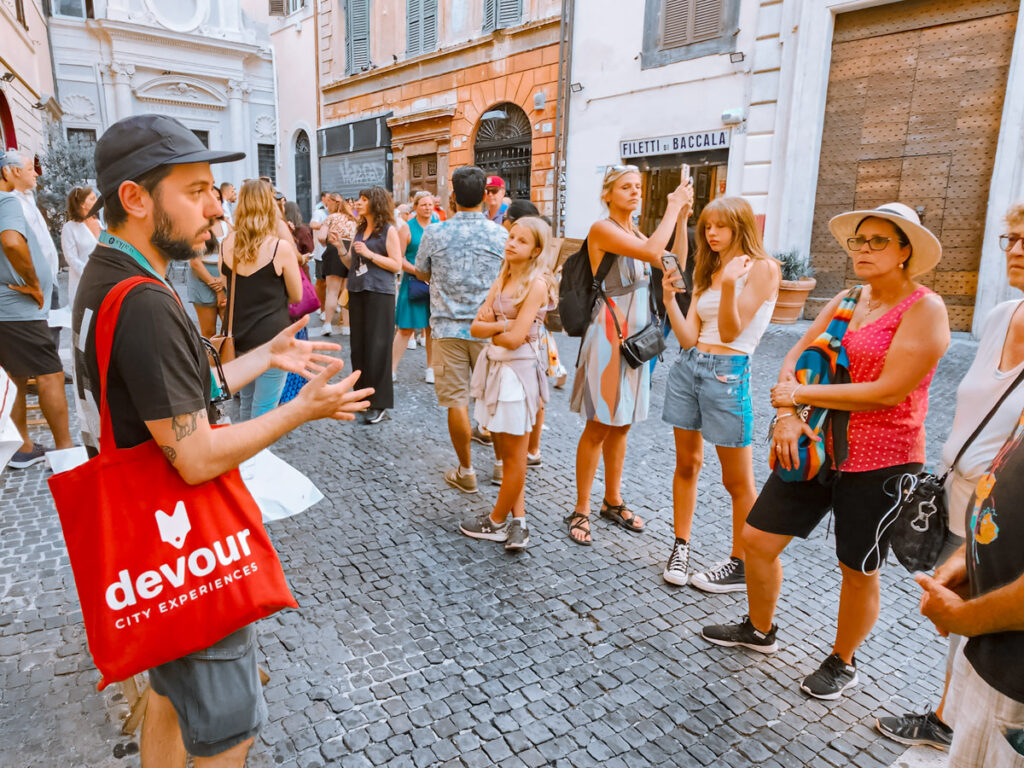
Rome is the largest city in the world in terms of size and because of its hectic lifestyle, many don’t have time to sit and eat. Therefore, street food is a very important part of Roman life.
We joined Devour Tours – a partner of Walks of Italy – to learn about the history of Roman cuisine and get recommendations on street food. We joined their street food and history tour of Rome with local guide Mattia.
Typically, this guided tour goes through the Jewish ghetto area but since it was the Sabbath, everything was closed.
Our guide Mattia took us to other cool neighborhoods in the Eternal City instead.
What we love about Devour Tours (we did a delicious food tour in Paris and Florence too) – and something you can tell the guides are extremely proud to be a part of – is that the small groups tours are focused on introducing travelers to local culture and food with stops only to small locally owned businesses.
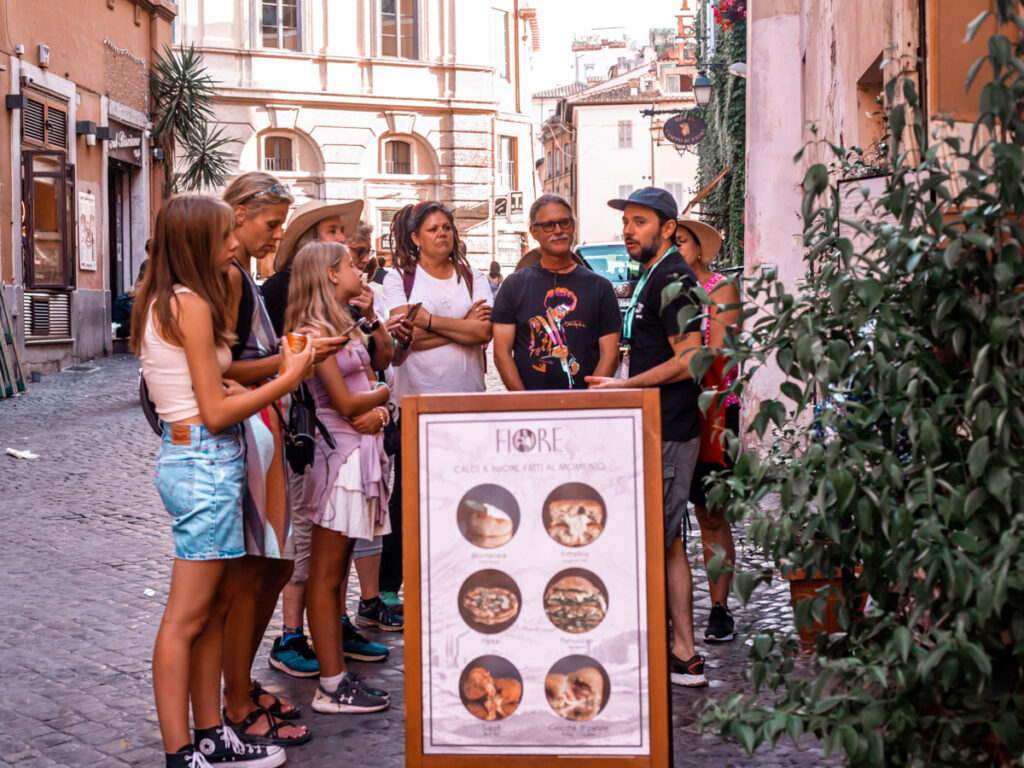
The businesses they know that don’t take shortcuts, use low quality ingredients, or not follow traditional recipes!
As Mattia told us, many now do that in the city because ignorant tourists won’t know the difference between traditional Italian recipes and those that are cheap copies.
Mattia feels this is disrespectful to Italians and tourists. He recognizes that power is limited to change politics but businesses like Devour that tell traditional, local stories can be a better approach that can make small differences.
He is a food lover, having grown up with a foot in Rome and one in Puglia, where his family comes from. As he described, Puglia is a place that overloads your plate with the invitation to “eat up or offend me.”
We started our tour learning about the importance of street food in Rome which was invented by the Ancient Romans. It became a small feature they replicated across their cities and towns in the empire.
They wanted a lively atmosphere in the town but also to distract from the conniving politics happening behind the scenes.
Rome’s Complex Layers of History
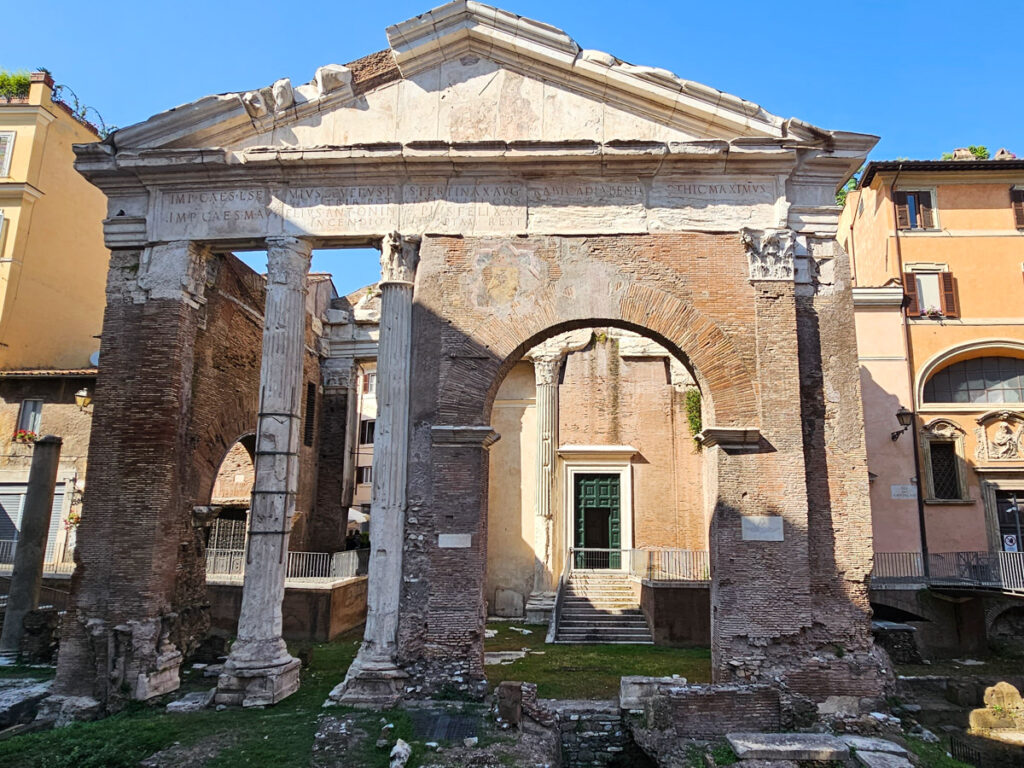
As we were meant to visit the Jewish Ghetto, we started in this area at the Portico d’Ottavia, an ancient Roman structure that enclosed the temples of Jupiter Stator and Juno Regina, as well as a library.
Mattia helped us to see that the buildings in Rome are like lasagna with different layers of history over 2,800 years, but also a bit like cake where things get mixed up.
Like this one which had Greek columns next to roman arches. The Romans would continue to update buildings using different materials and designs as the eras evolved and their empire grew, which is why it’s often hard to understand what you’re looking at amongst the Roman ruins.
It is important to look at the details of the story, like the statue of a man next to a boat looking down at the fish which shows It was once a fish market (from the medieval period up to the end of the 19th century.)
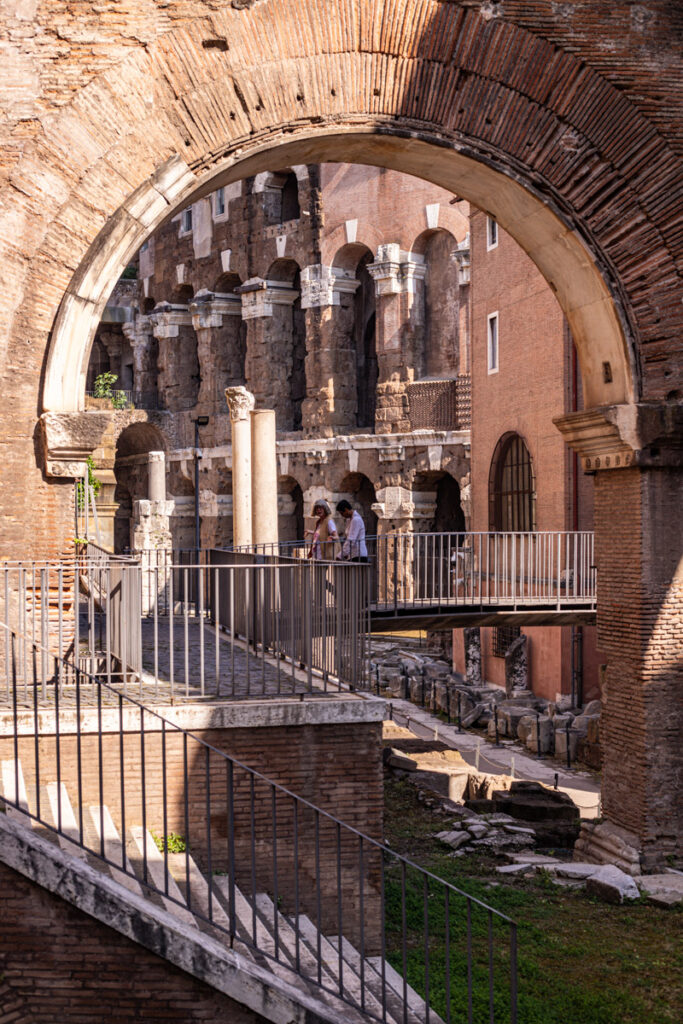
We heard many times during our stay in Rome that reusing materials was important. Each new Emperor would pull down materials to build something new. It was because they had no time to transport new materials in as they knew their time to leave behind a legacy was short.
Consider that as you move about ancient Rome and its ruins. These important insights really helped me understand Rome better throughout our stay.
Jewish Quarter History in Rome
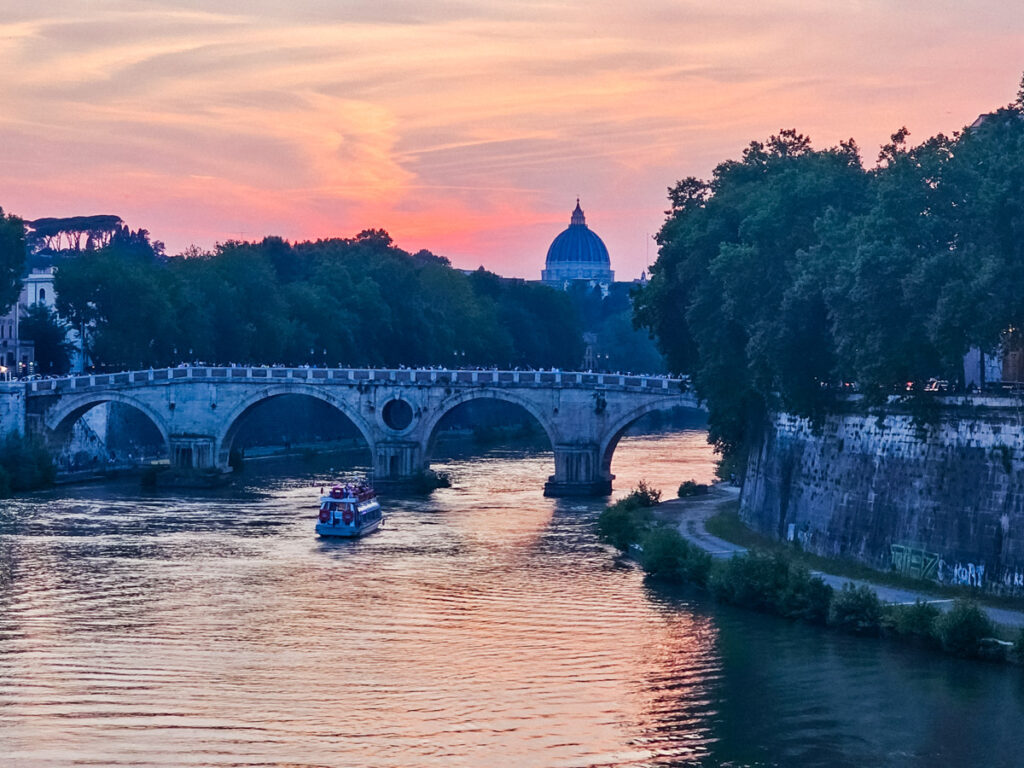
Mattia then shared with us the history around the Jewish Ghetto. It started in the 1500s when the Pope gathered all Jews in one place and built walls around with gates.
They were not Romans anymore. They could not own property, lived in small homes that housed 1-2 families, had a nightly curfew, and had limitations on food, only allowed leftovers.
To survive they needed creativity which they did by changing Italian recipes or making new ones that respected Kosher laws.
The area was next to the center of Rome (now a cool area) Back then the Tiber wasn’t nice as it didn’t have retaining walls, and flooded all the time, so the Jewish area was always muddy.
After the reunification of Italy in 1861, the Ghetto was destroyed and rebuilt. The Jewish bought the land and decided to build their own community with synagogues etc. and they were free to live wherever.
Then World War 2 happened, and many Roman Jews were arrested and sent to camps. Out of 1023, only 16 came back after the war.
Throughout the Jewish Quarter, you’ll find gold stone steps showing the names of those taken away to remember.
After the war, everything changed, and they were thriving again. Since they are Romans, you will find Jewish cuisine all over Rome. And our first stop on the Rome food tour allowed us to taste some of it!
Stops on the Rome Food Tour
If you do this street food and history tour in Rome, your food stops may be different during the week and on Sunday. The awesomeness however will still be the same.
1. Jewish Artichoke at Bona Pizza
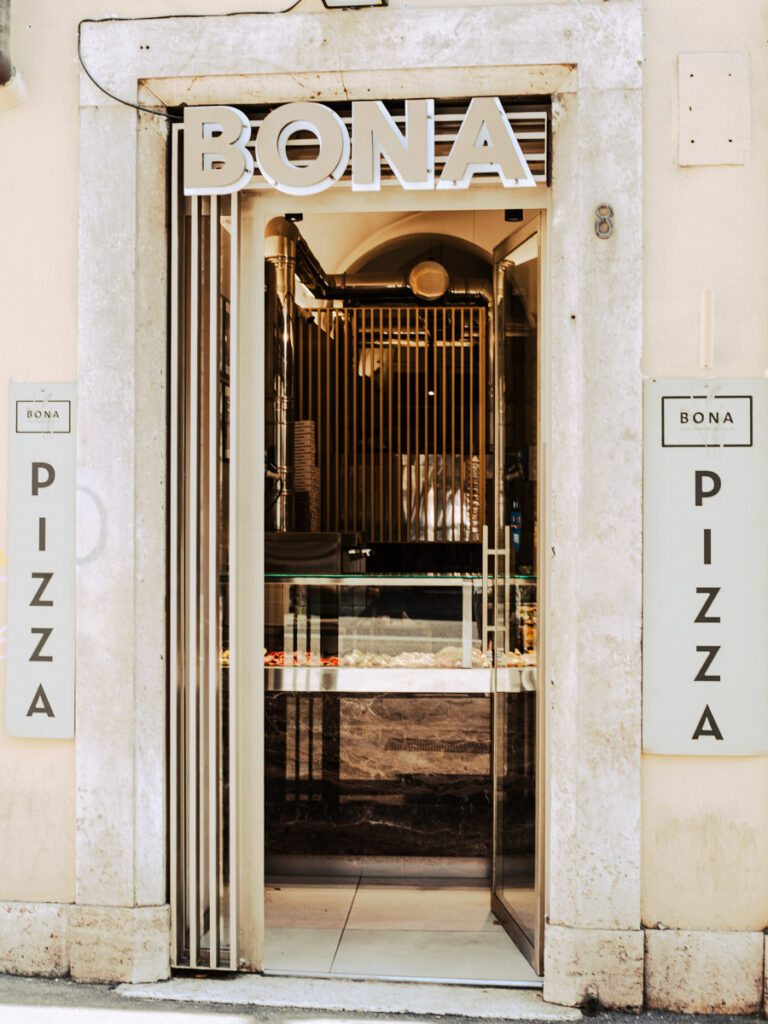
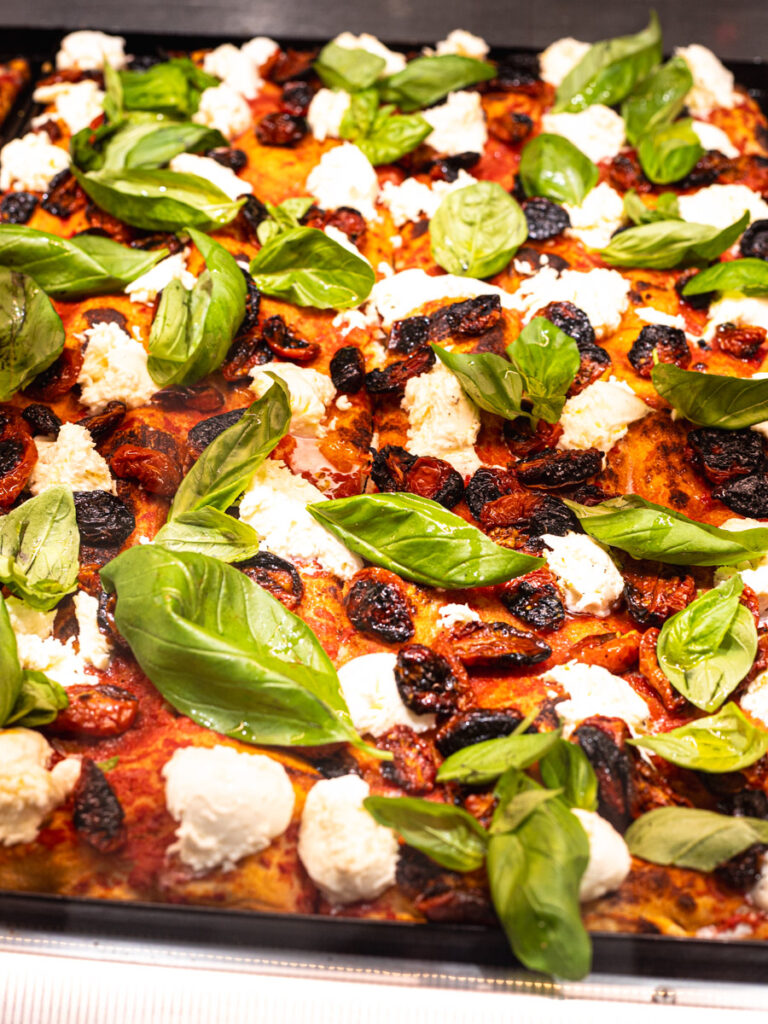
Our first food stop, Bona Pizza, for deep fried Jewish Artichoke. It was the perfect beginning to what was meant to be the Jewish quarter food tour – a local pizza chain owned by a member of the Jewish community.
As they mostly sell pizzas, we also learned about Roman pizza and how it differs from the more famous Napoli.
Roman pizza is square with a crunchy crust. You see what you get as they are on display in the warmed counter. It all goes by weight, so you get to choose how big you want your pizza slice.
In Rome, it’s common for you to argue with another Roman as to whether you fold the pizza as you eat it or not. But for us it was artichokes.
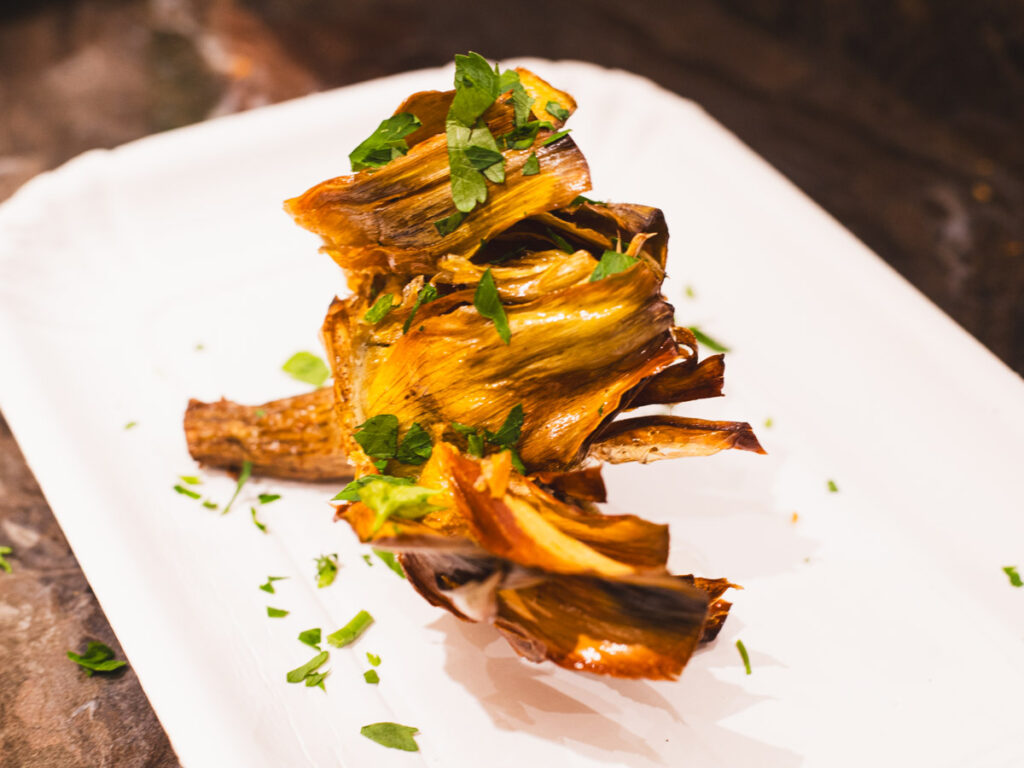
The spidery looking vegetable arrived on the plate, and we were invited to pick it up and eat it like a sandwich. They double fry it which means it’s crunchy on the outside while being sweet and soft on the inside. They were deliciously Moorish, just like fried potatoes.
Bona has had great success in Rome and now has several locations across the city. As they like to say, Magna Che e bona – eat it’s good!
2. Sacred Area of Largo Argentina

In Rome, you turn a corner, you see another ruin, and one that stuck with me was the Sacred Area of Largo Argentina.
Why? Because it’s now a cat sanctuary – why else?
This paved square that houses the ruins of four temples has somehow become the home to about 90 cats.
But, we did not see one – any time we walked past here during our three day stay. After seeing the cats of Athens ruling the city, I was slightly disappointed in Rome!
These ruins were uncovered whilst digging to build homes for the homeless during the reign of Mussolini.
Archeologists knew they discovered something important and begged Mussolini to save it (he had destroyed many ancient forums to build roads to impress Hitler).
But he agreed for this one so he could show he was working to restore the Roman empire.
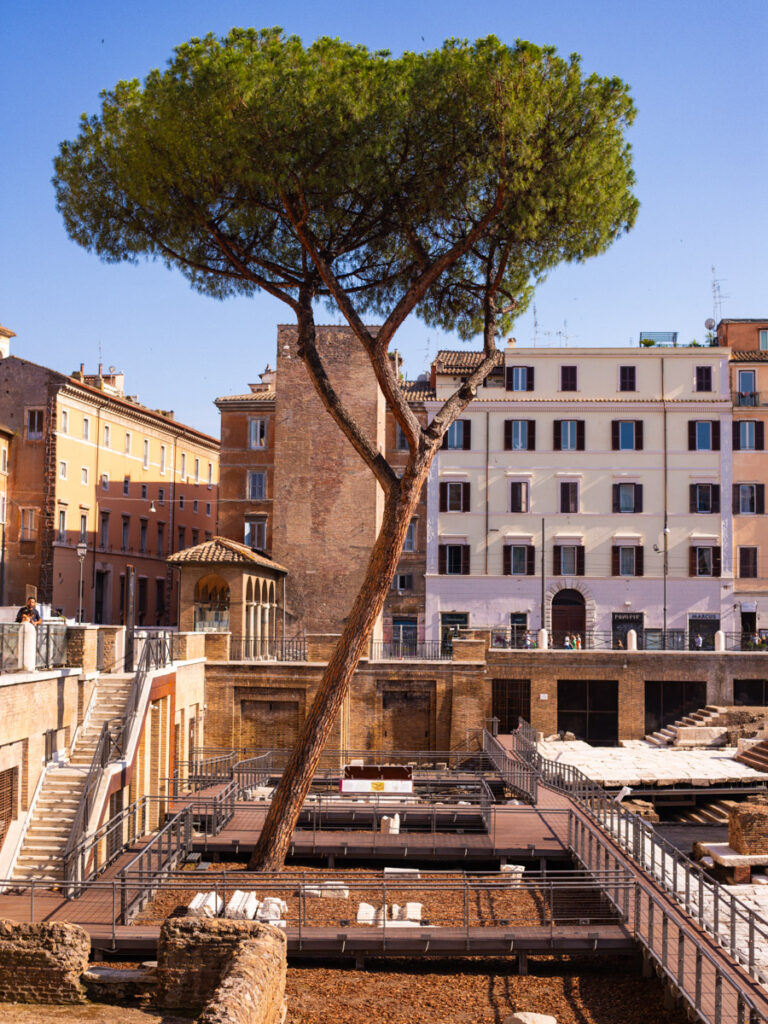
The well-known luxury brand, Bvlgaria, now funds its restoration, something Mattia told us was common in Italy. As the government doesn’t have the funds to keep up with restoring the ancient ruins, big brands do it to have their names associated with it.
A Tuscany shoemaker paid to have the colosseum cleaned of car smoke.
It was only the day we left Rome that the Sacred area of Largo Argentina was reopened to the public with a path going through the ruins for a closer look.
3. Codfish from Filetti di Baccalà

On to our next stop through the area where the old Theatre of Pompey, (Teatro di Pompeo) once was.
Mattia pointed out how the streets and buildings now retain the curved shapes of where the rows of seats once were. On the roof of the Santa Barbara church in the trapezoidal-shaped square you can still see the back part of the theater seats. When in Rome look up, down and all around – there are many stories to be told.
On this square we joined many other happy tourists drinking wine while sampling some specialty street food from what the Irish would call, a chipper – a small place to pick up fast food – mostly chips (fries) and fish.
Like those chippers, this one, Filetti di baccalà, also has a small one-page menu, most famous for fried cod fish.
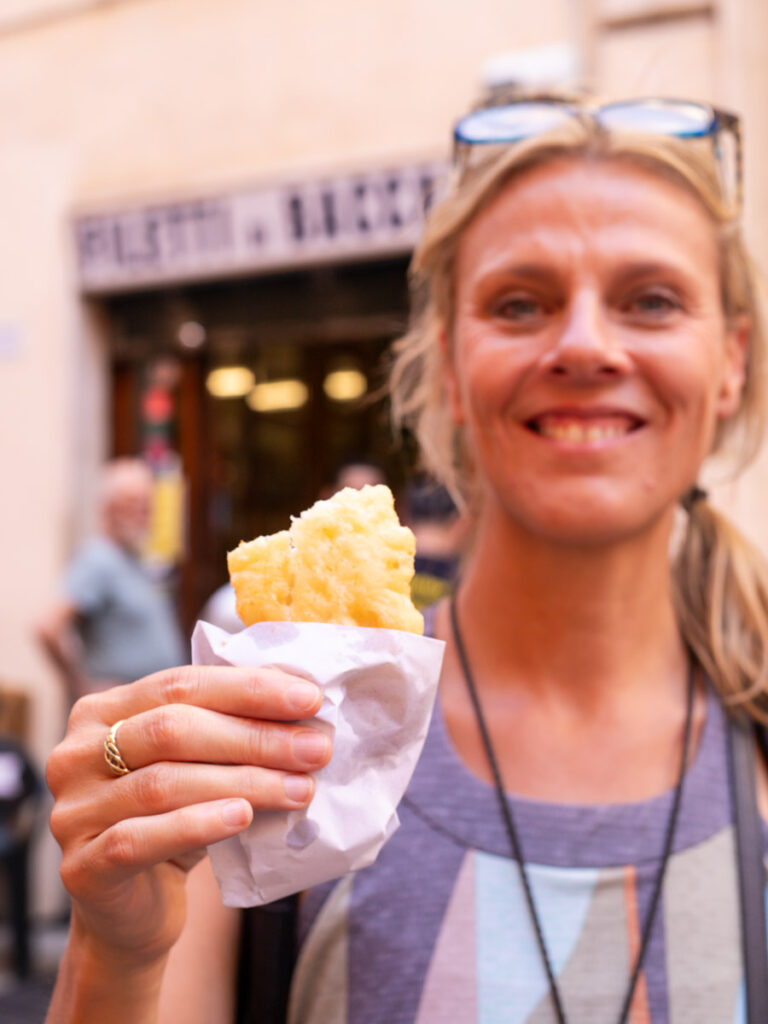
It opened in the 30s and was taken over by Marcello in 1978 under the condition that he would continue to sell codfish and would first spend a year learning the art of preserving it in salt for 18 hours.
We enjoyed this oily, salty dish with a glass of Pecorino, a typical Italian house wine as we learned the owner’s story and that of the codfish, which is thought to have first come here from Napoli by way of the Swedes!
FUN FACT: In writing this, I uncovered some research that suggests the Chipper in Ireland has its origin with an Italian man from somewhere in between Rome and Naples!
4. Red & White Pizza at Campo de’ Fiori
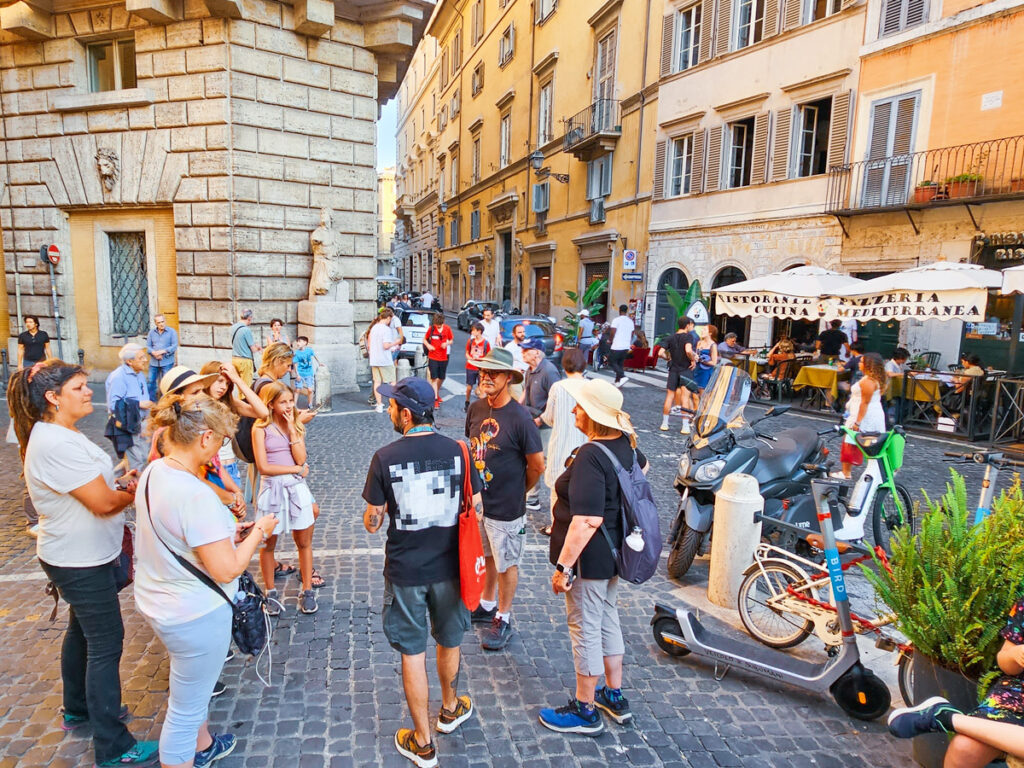
We wandered through more cobblestone streets named after craft traders and stood at the crossroads of those who once made nails and those who made keys.
As you walk through the city streets, even the smallest details bring the past to life. The vibrant atmosphere allows you to vividly experience the bygone days, while simultaneously immersing yourself in the present vibe. The finest cities manage to preserve elements of their history as they continue to evolve and embrace the future.
These little details we would not get without a great tour guide who was local to Rome.
It would just be people wandering the cobblestones and drinking on restaurant patios and bars. All great to experience but even better when you learn where this richness comes from.
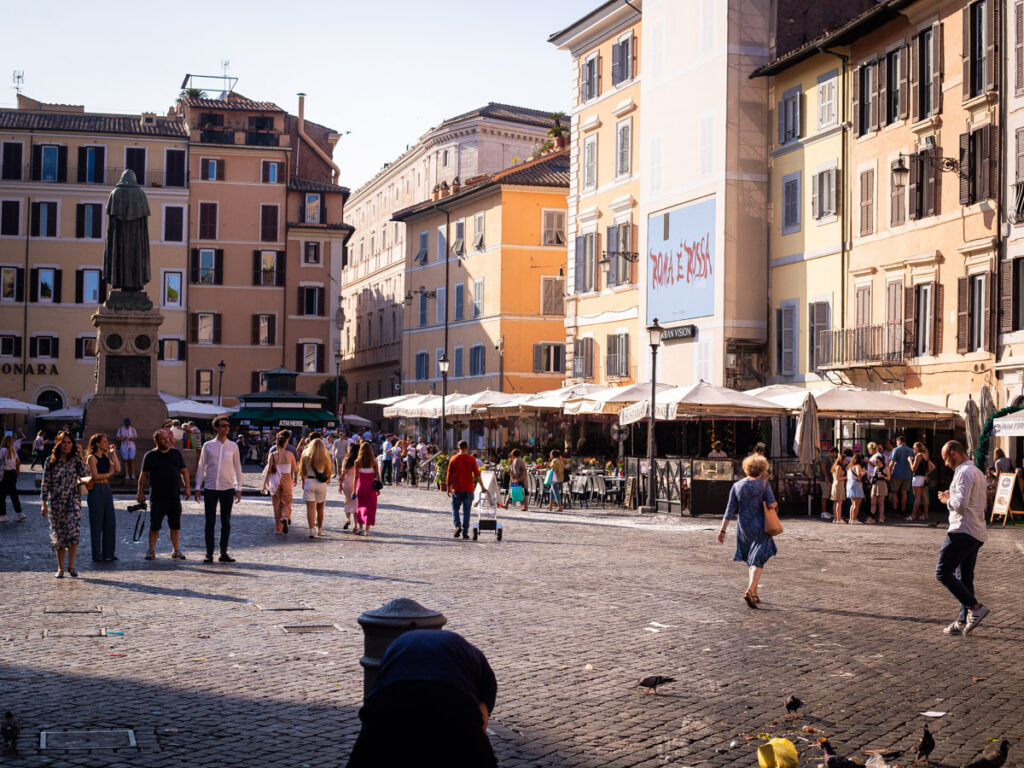
These roads lead us to Campo o de’ Fiori, which is very famous for its markets.
I had added these markets on my wish list of things to do in Rome. I was grateful for the inside scoop from Mattia to learn these markets are now just a tourist attraction. Locals no longer really live in Rome, so for the vendors to survive they sell to tourists.
I recommend doing food tours first thing when you arrive in a destination as it helps you learn things to miss, things to see, and what to come back and explore more in-depth!
The markets had finished for the day when we arrived early afternoon, so we instead stopped at a small bakery, Forno Campo de ‘Fiori, a place that has been baking traditional bread for more than thirty years.
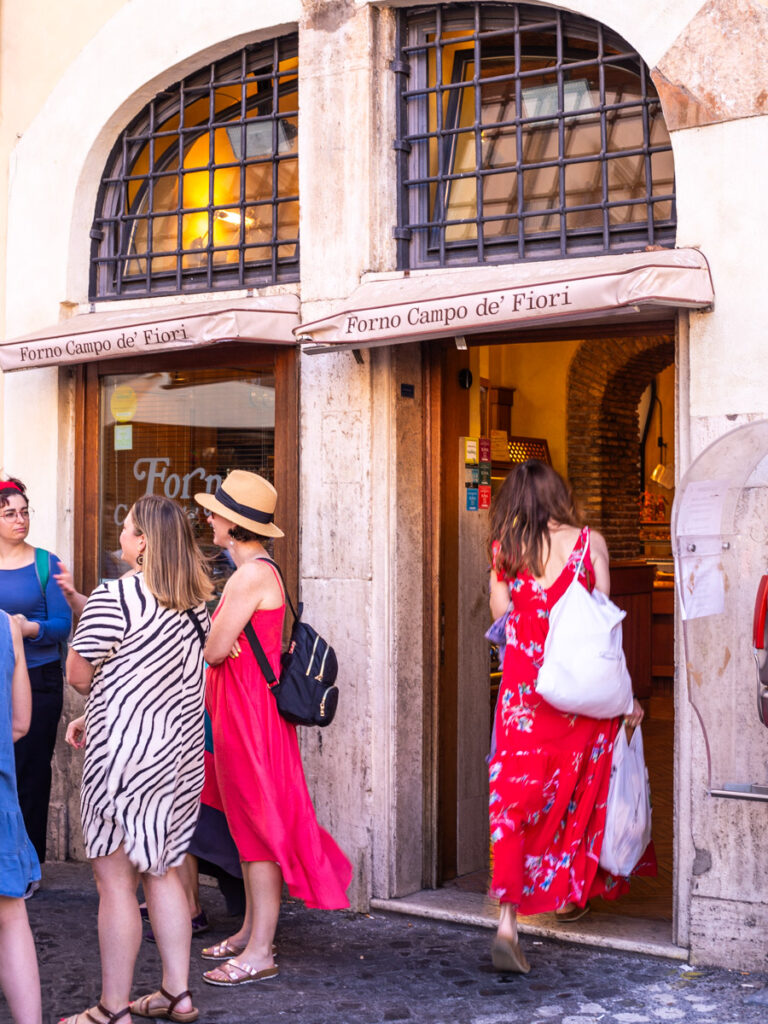
In Italy, less is more, and at this bakery we were trying typical quick and easy Roman snack food – red and white focaccia – a mostly naked version of a pizza.
This originally was pizza made for the lower-class. Nowadays famous chefs in Rome acknowledge the forno (bakery) as being the Godfathers of the tasty Roman pizzas they make as it all starts with the quality of bread!
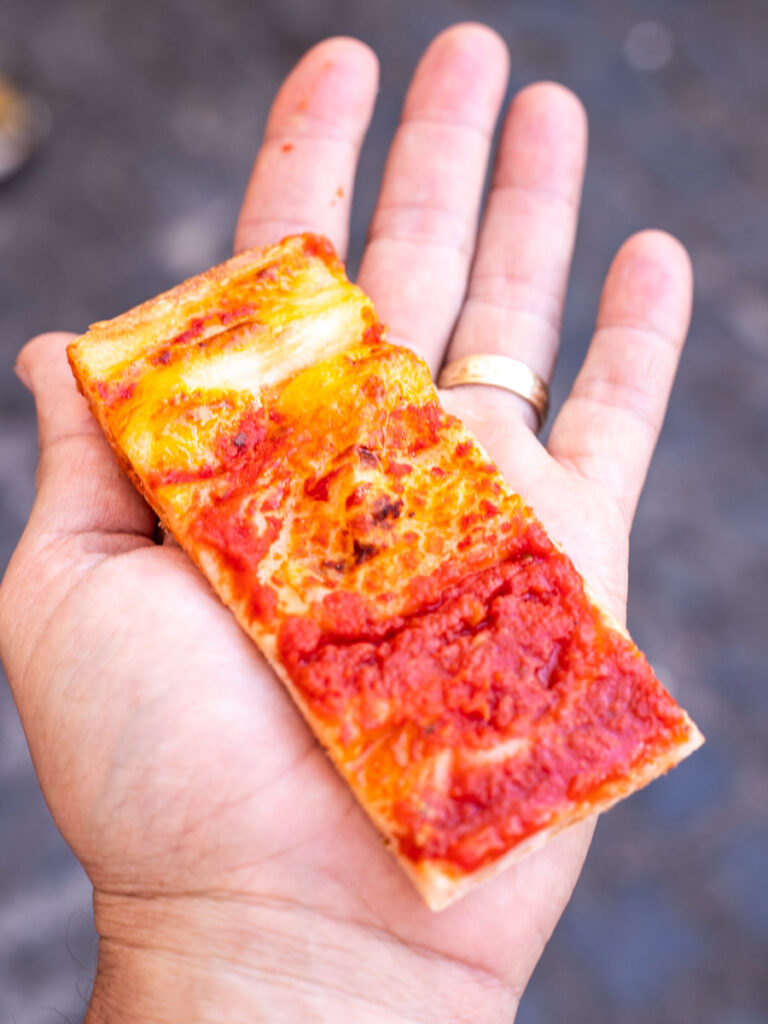
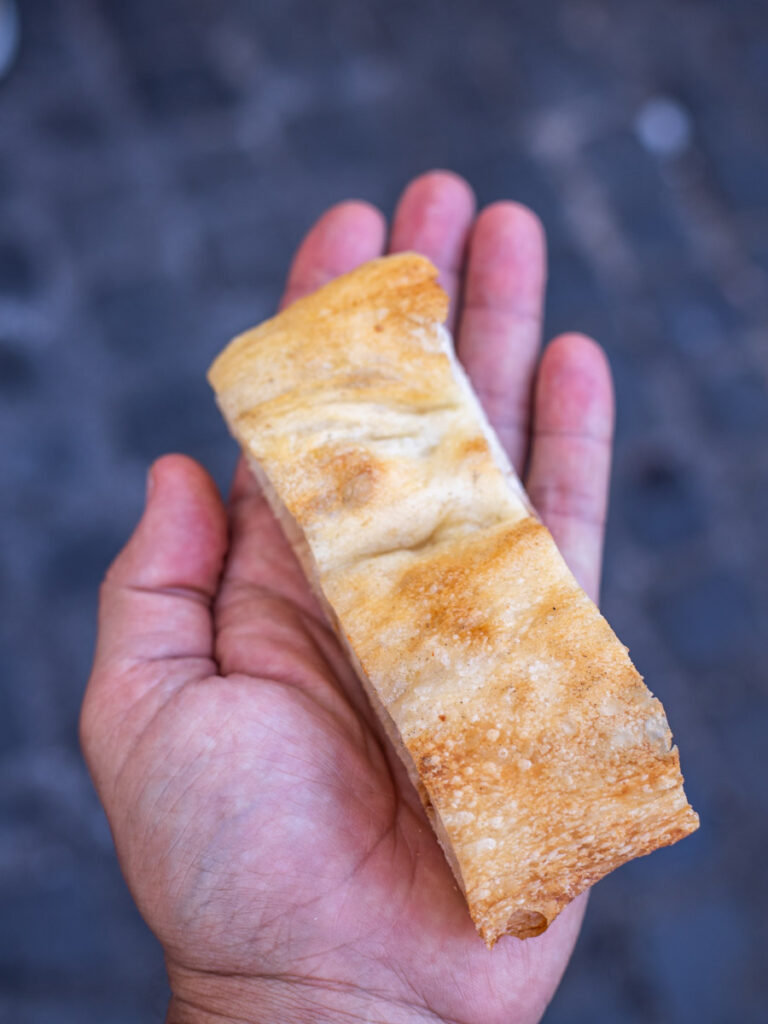
It was while munching on the white (garlic butter) and red (tomato sauce) slices that I had an insight into why my cooking skills aren’t quite up to scratch when Mattia dropped this truth bomb about the Italian food:
“In Italy. less is more. In other places they pile on ingredients only because they don’t know what to do to make it tastier.”
Point taken. I will work on simplifying! How does meat and three veg sound?
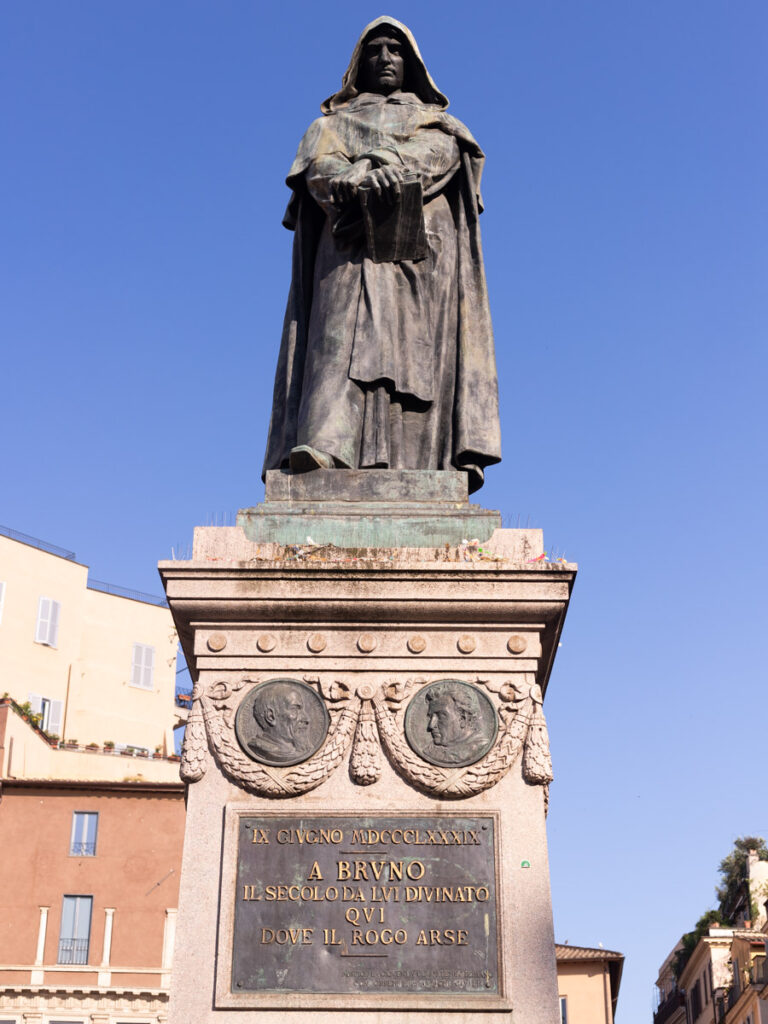
I loved learning more about the role of the Pope and the Catholic church in Rome’s history. I might need to reserve my thoughts on that over a good bottle of Chianti in real life with you. But let’s say I gave a fist pump to the statue of a heretic philosopher from the 1600s who stood over us as we ate our pizza.
He was burned alive by the church in this square once known for executions for thinking differently. The statue was created at a time when people were starting to revolt against the church. You can see this in his fierce expression and burning eyes that are in direct line with the Vatican warning that he will always watch you to remind you of what you did.
As is typical in Rome, you grab your street food snack, eat it standing around outside, and then quickly move on.
5. Craft brews at Johnny’s Off License
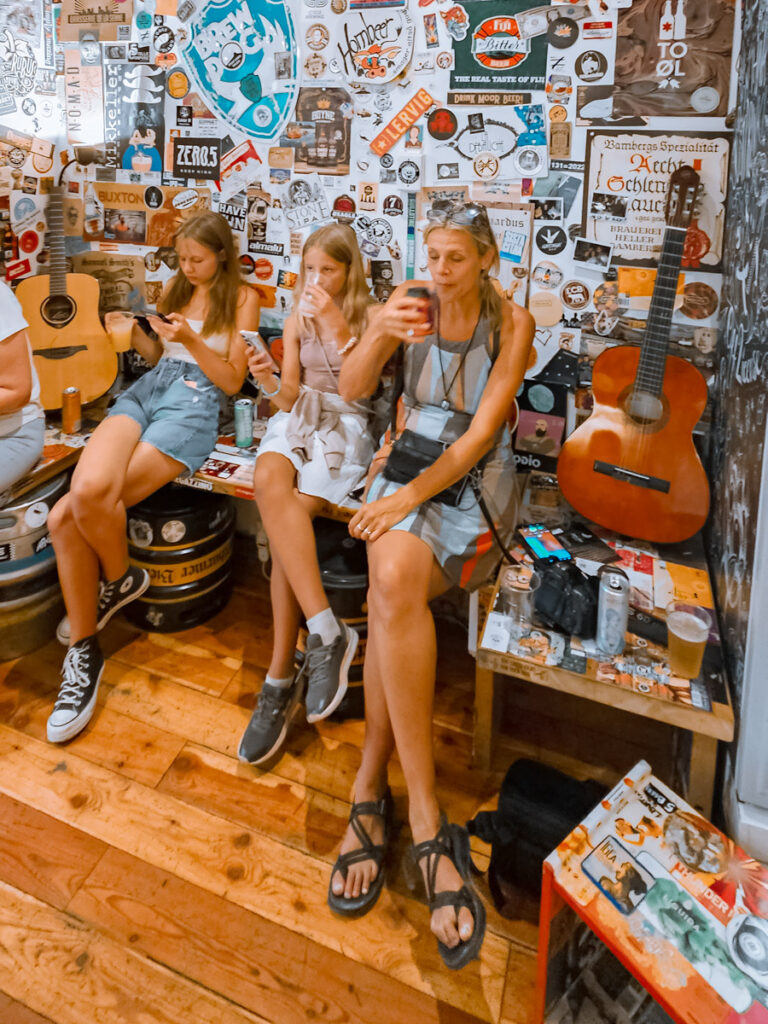
So, we did. Down a lane, past an old palace, and past a few more fountains and statues to an unexpected stop – Johnny’s Off License – that’s a bottle shop/ tap room for our American readers.
It was time to balance the salty food we’d been eating with a refreshing Italian craft beer.
Craft beer is relatively new in Italy, beginning in 1996 with just six breweries, five in the north and one in Rome. It quickly gained traction and now there are about 100 craft breweries across the country. Johnny’s is the second off license in Rome.
Breweries are all different – some have food, others just tap beer, still others have games and live music, but all are very social spots.
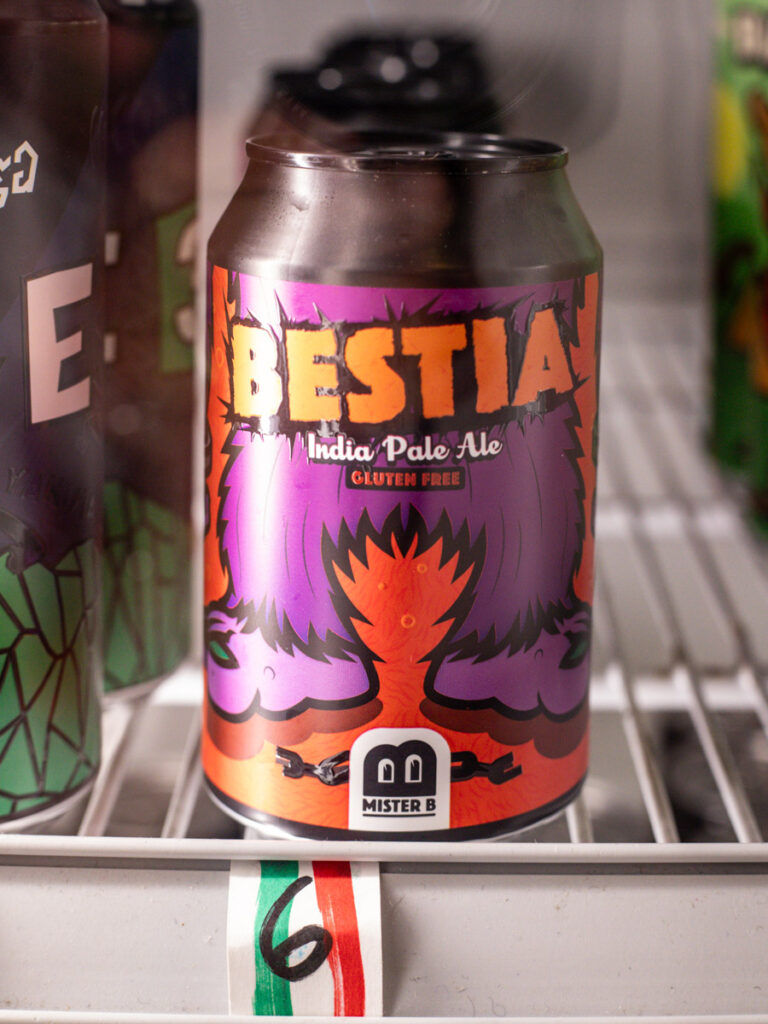
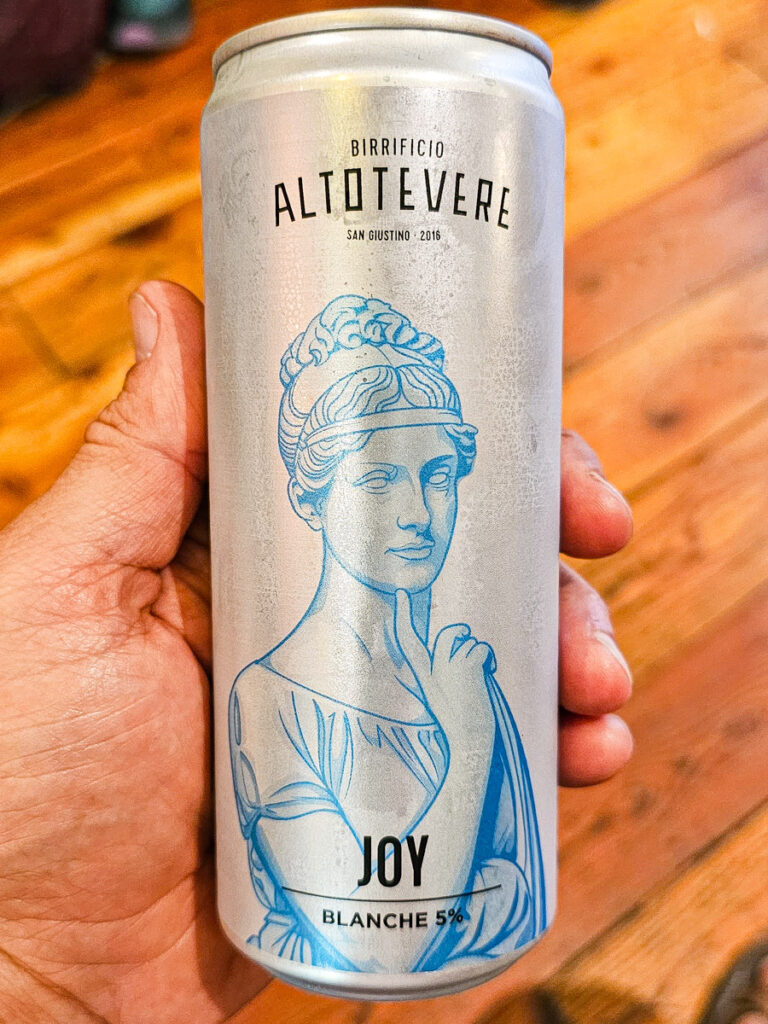
We had a selection of local craft beer in the fridge we could choose from, including gluten free IPA, which I was thrilled about. We, of course, had sodas for the girls!
It was fun sitting around chatting as a group and learning more about Italian and Roman culture from football to brewing, drinking culture, and maintaining respect for tradition especially when it comes to food.
You may think this food tour has come to an end with a refreshing ale, but we still had to wrap up this three-hour tour with sweets. But, we weren’t quite ready for that yet.
6. Suppli at Fiore
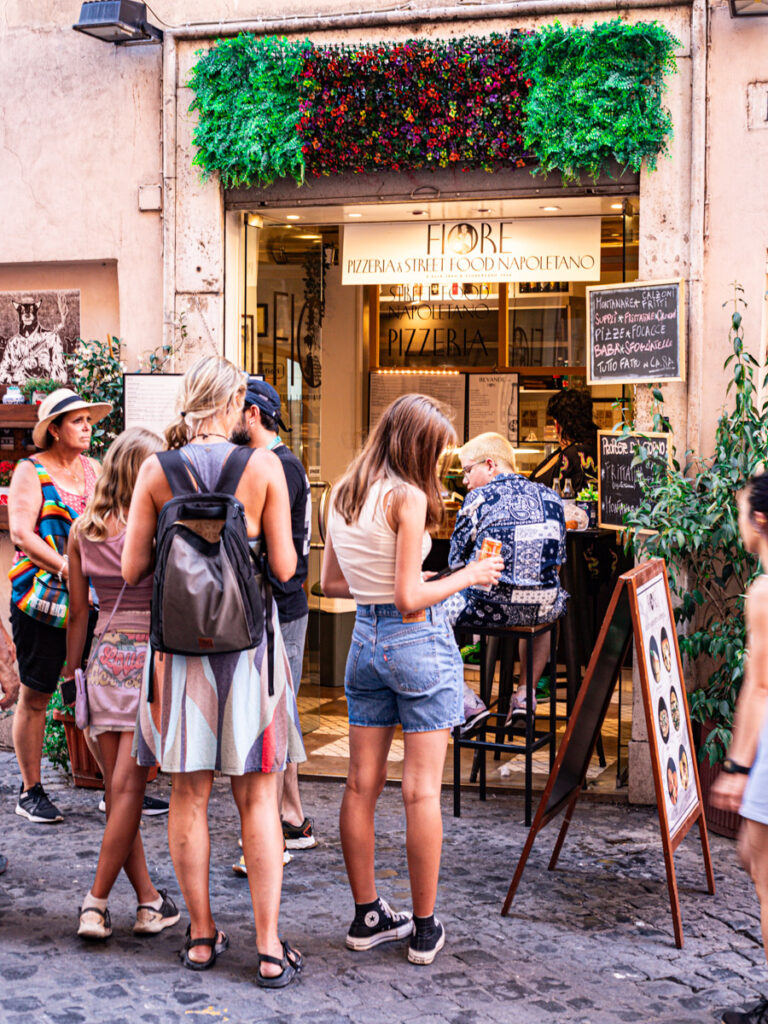
First, we had to eat the Roman version of an arancini – suppli.
Arancini come from Sicily and are more widely known around the world because the majority of immigrants from Italy were from Sicily.
Suppli street food was originally made for lower class and was filled with rice, chicken giblets and whatever cheese was hand because it melts anyway. It’s now evolved to mozzarella and ragu. It was delicious and with its rich tomato flavor tastier to me than an arancini.
Suppli, Mattia tells us, is the perfect snack for mid-morning or mid-afternoon when you need more than an espresso and a great accompaniment to beer.
However, Nor all suppli are good suppli. There is nothing worse than a Roman than biting into a suppli and it’s awful.
Kinda like me with coffee. (I’m looking at you America, like that statue looking at the Vatican!!)

We were eating our suppli at a small hole in the wall, Fiore, which is owned by a family of fried street food makers from Napoli. So yes, you will find some snacks from Napoli here as well!
All the suppli are hand rolled and are legit. The debate was settled with Devout tour leaders tasting various suppli across the city to find the highlights.
Fiore was voted best suppli in Rome to be included on the local food tour. Other food tours in Rome will take you to the more touristy places rather than hidden gems and secrets.
Then Mattia pulled out a surprise, the sweetest smelling donut-like treat from this store.
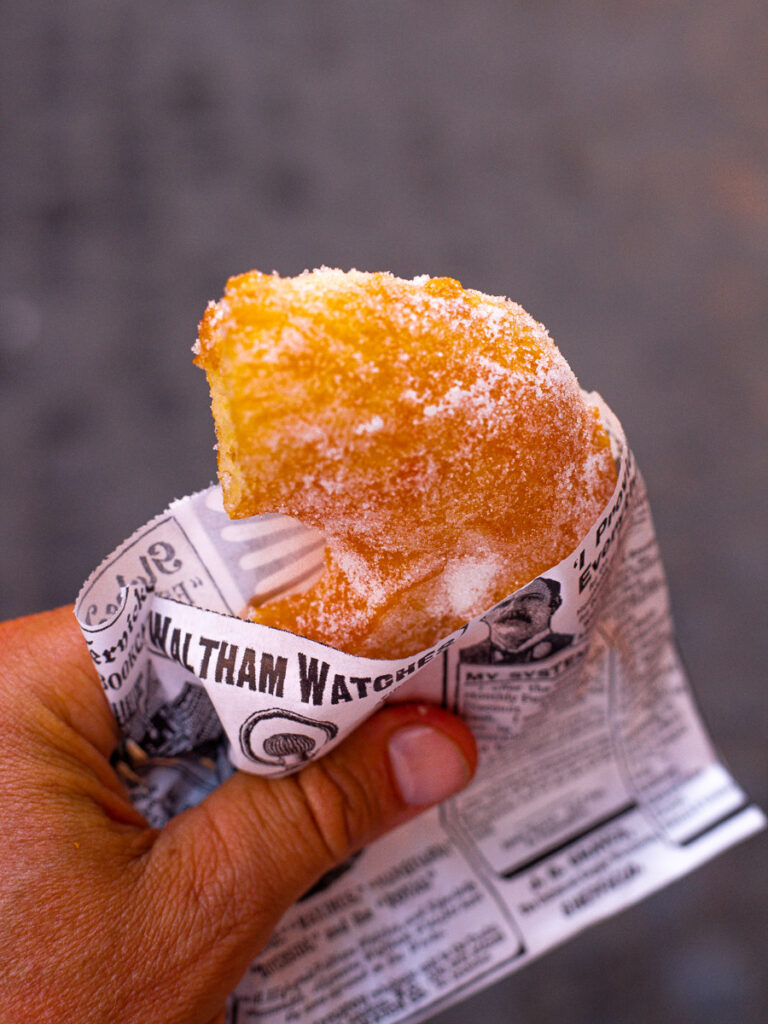
The girls’ eyes lit up as they devoured what was like a cinnamon donut I’d have as a child. One sniff of that freshly made donut would send our eyes watering.
Graffe used to be for special occasions, but now these Italian donuts are everywhere. It comes from the Austrian version, krapfen.
They bought it when the Austrians ruled over the Napoli kingdom.
We learned on our Paris food tour that the Austrians (Viennese) also brought croissants to France! And then a few weeks later we visited Austria and did a food tour in Vienna! Love how places in Europe connect together like jigsaw puzzles.
We still had one more sweet to go – and I’m sure you know what we finished this Roman food tour with. BUT, can you believe we still have one more savory food stop? Thankfully this was the evening tour, so dinner was more than adequately covered for the night!
7. Pork sandwiches at Porchetteria La Rinascita

The narrow streets we walked past were buzzing with people standing outside bars drinking or eating outside. This was our first night in the city and I could not wait to discover more in our following two nights. We enjoyed Paris immensely just a few days before, but Rome really captured our hearts, with a personality more suited to ours.
At this food tour stop we sat around the small interior of Porchetteria La Rinascita.
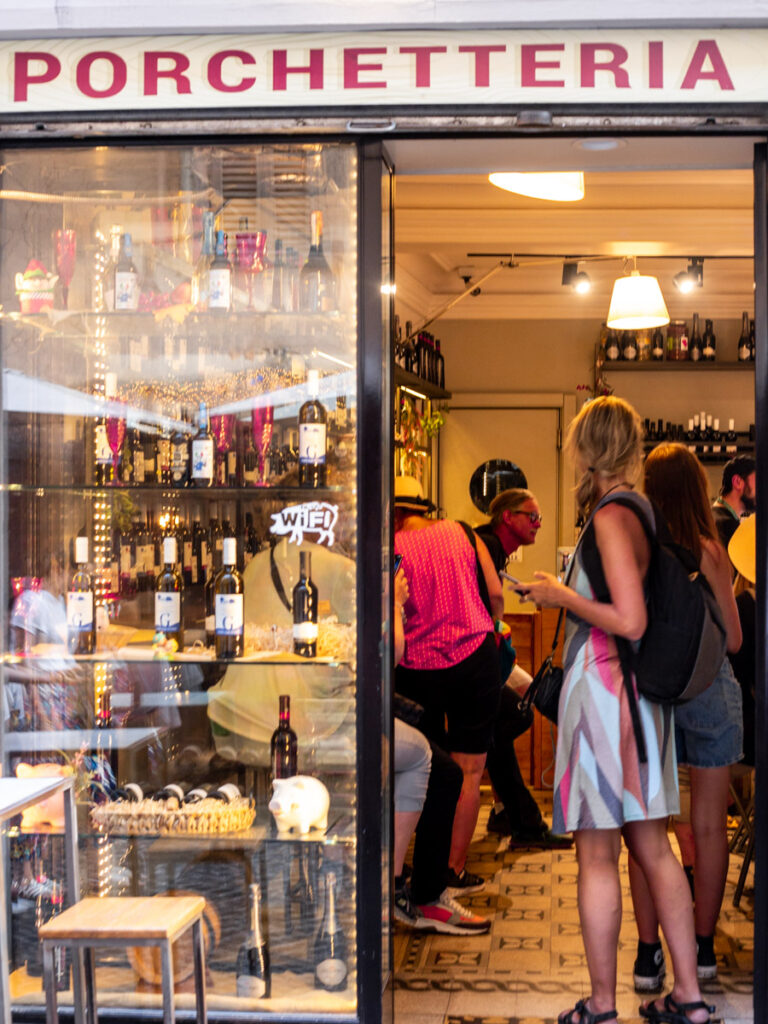
First look in the window will tell you what they sell here – a full boned pig sits on display. Porchetta is typically rubbed with rosemary, fennel, garlic and pepper, and roasted whole in a brick oven for at least 8 hours or spit.
This is food typical of Umbria in the central part of Italy and not too far from Rome. The owner only comes here to deliver pigs from his farm in Umbria where he makes everything.
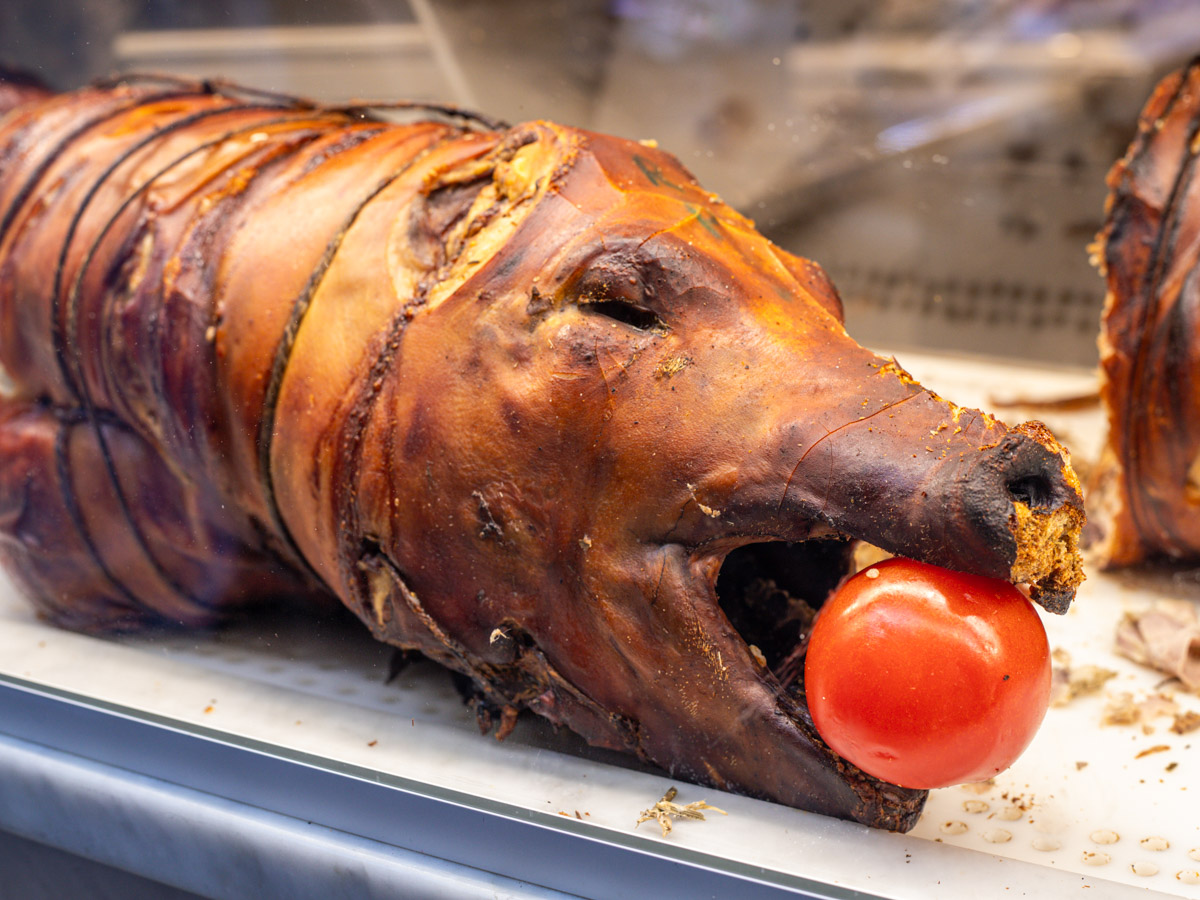
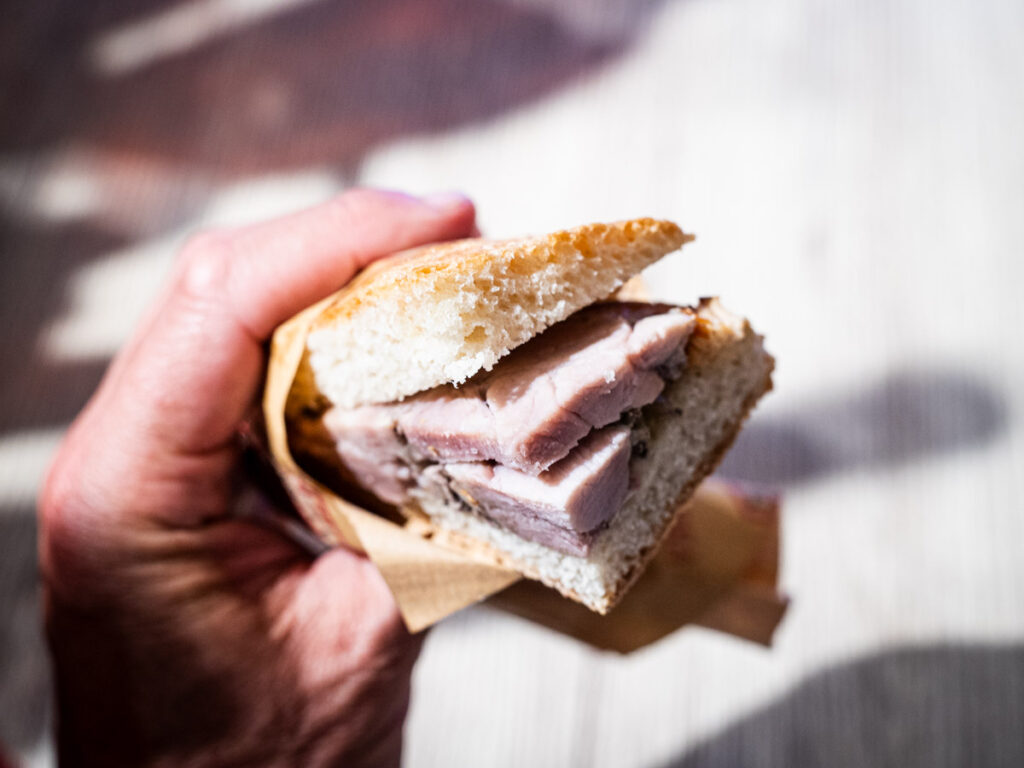
Remember the delicious flavor of Italian food comes from simplicity. So here we sat eating authentically with just meat and bread. No sauces needed. It was incredibly tender, juicy, and flavorful.
While not a traditional way of eating it, Porchetteria La Rinascita also offers more creative sandwich offerings.
8. Gelato at Gelateria del Teatro
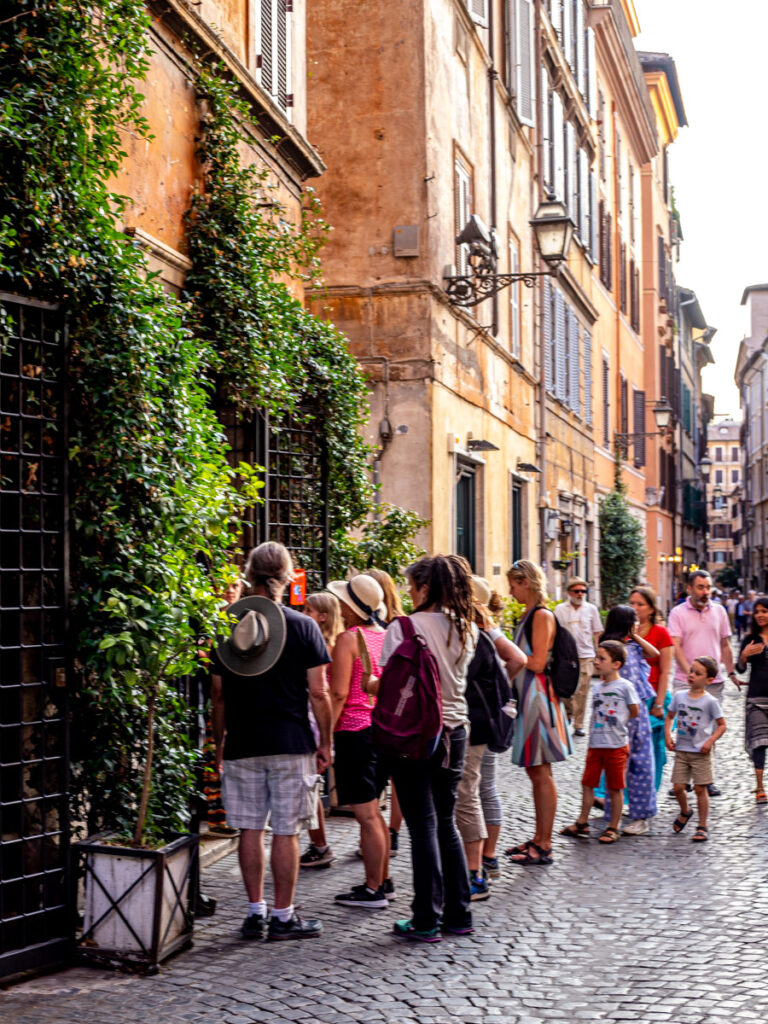
To end the tour, we walked along the lovely Via dei Coronari, cobbled Renaissance Street lined with antique shops, boutiques and costume jewelers. Named for the Rosary bead sellers who once lined these streets supplying the pilgrims as they walked along this old Roman road leading to St Peter’s Basilica in the Vatican.
This one was taking us straight to a new form of Italian worship, gelato.
I do not have a sweet tooth, but gelato is something I can eat daily. It’s rich and creamy rather than sickly sweet.
I was quite amazed that a food tour would give us all the food so far AND two healthy Scoops of gelato.
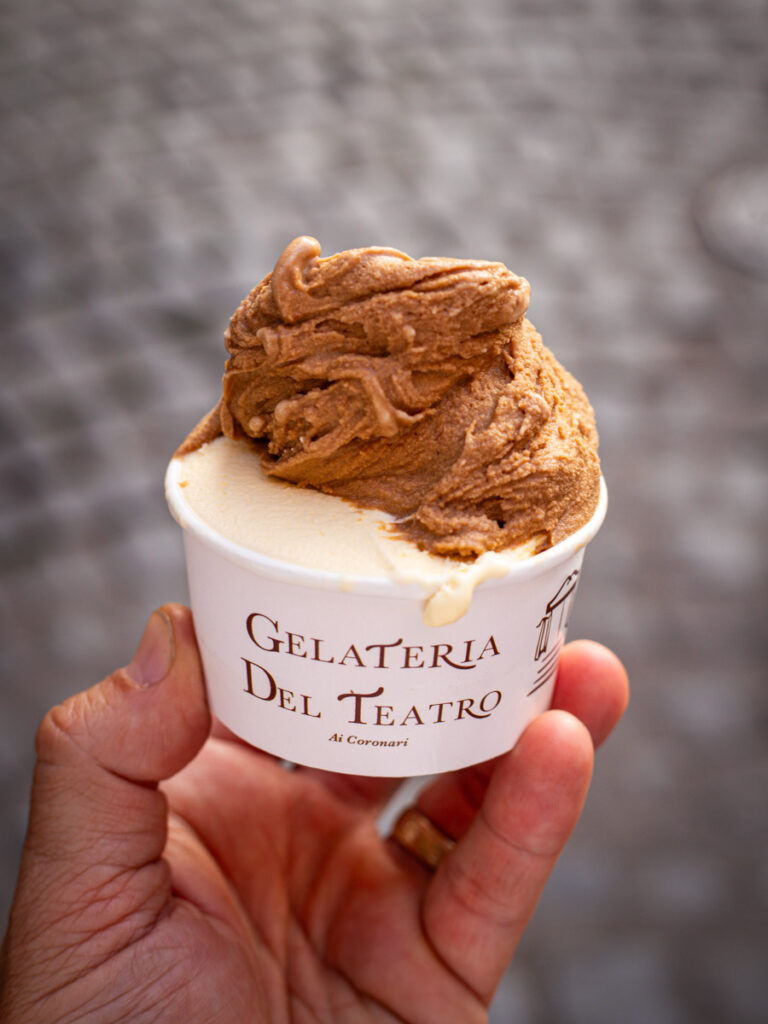
Gelateria del Teatro is one of the most appreciated and loved ice cream parlors in Rome in the artisan field since 2006. They have a long list of old and new innovative flavors, such as white chocolate and basil, Rosemary, honey and lemon, and Raspberry and sage.
We settled for some basic coffee, chocolate and stracciatella which was simply delicious.
The gelato is made with fresh, natural ingredients and you can even watch them making it through the window outside.
Mattia gave us his most important insider information of the whole tour – how to pick a good gelato place as they are as ubiquitous as chippers in Ireland, and not all are created equal.
- Look at the size of gelato. It should be inside tanks only on top of it.
- All colors need to be pale. Pistachio should never be never fluorescent green.
- Every flavor should have its own texture and look different to each other. Imperfect gelato is good.
- You should only ever put cream on top of gelato.
- Gelato should only use a few high-quality ingredients.
Check rates and availability for the street food tour here.
Devour Tours also have the following food tours in Rome:
- Trastevere at Sunset: Rome Food & Wine Tour (we stayed in the Trastevere neighborhood and loved it. Tried to do this tour but it was sold out!
- Tastes & Traditions of Rome: Testaccio Food and Market Tour
- Rome Pasta-Making Class: Cook, Dine & Drink Wine With A Local Chef
Why not do them all?
FAQs About Rome Food Tours
Below is what people ask us about food tours in Rome…
Are food tours in Rome suitable for vegetarians and vegans?
Food tours in Rome are suitable for vegetarians as there are usually veggie options available on the tours. If you are vegan, or have dietary restrictions or food allergies, it’s best to inform the guide beforehand so they can accommodate you. For example, we’re gluten-free, so they helped point out what I could and couldn’t eat.
What is the most famous food in Rome?
Most people think of pasta when they think of Rome. There are many flavors of Rome, but pasta dishes are typically the most famous dishes that Rome is known for. Don’t forget to try Roman pizza and suppli, two other famous foods in Rome.
What monuments do you see on a Rome food tour?
Depending on what tour you choose, you typically walk past the UNESCO World Heritage Site of the Roman Forum, Colosseum, Trevi Fountain and Pantheon. You may also walk through the vibrant Testaccio and Trastevere neighborhoods.
Is there alcohol on a food tour in Rome?
Typically, there will be a chance to do some wine tasting on a food tour of Rome. There will not be as much wine as you would find on a wine tour, but most food tours will point out a good place to try some wine.
In Conclusion
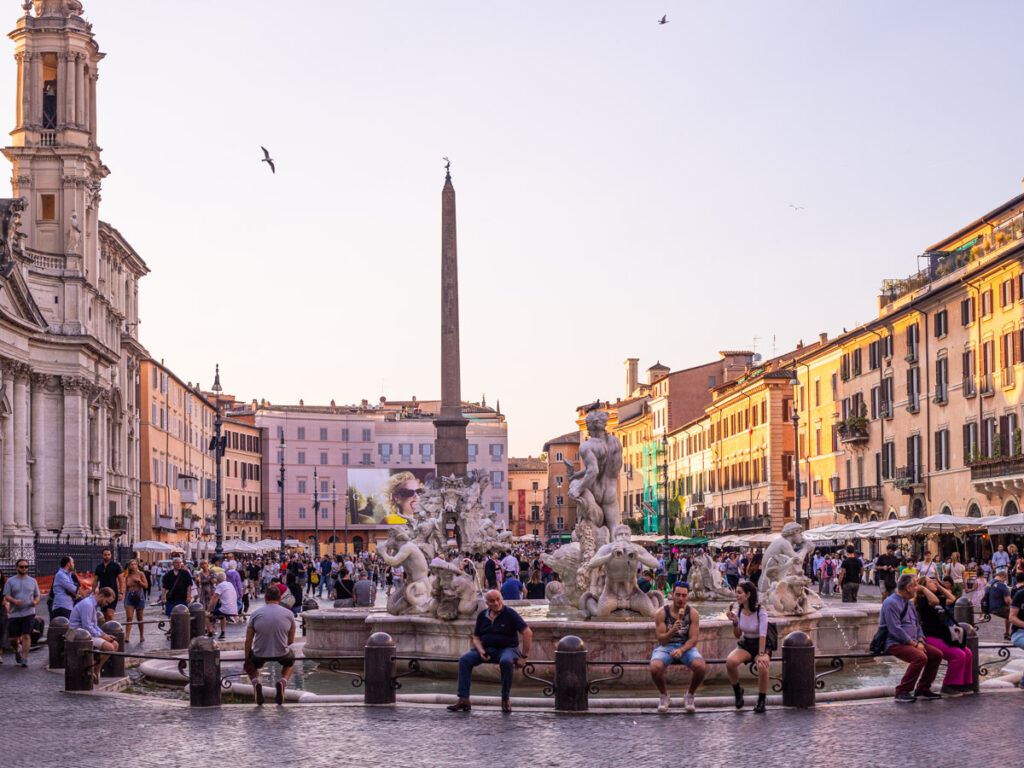
So, there you have it, this is what you can expect from one of the best food tours of Rome!
Our street food and history walking food tour of Rome was of outstanding quality, both in the food we ate and the insights we gained into Roman history and culture.
It was the best way to combine a bit of sightseeing and learning about the city. I learned so much from this trip and walked away understanding, and loving, this city even more.
The girls had a fantastic time and enjoyed all the stops, and we enjoyed comparing notes after as to what our favorite foods were. The suppli and gelato were the clear winners for all of us. Of course it was one of their top tours in Rome for teens.
I loved how we went to local spots and apart from two stops on the tour, were not any other foodie tour groups!
I couldn’t have asked for a better travel experience. I love this tour company and will use them repeatedly. They really get to the heart of the local community and culture – and respect the stories within it.
You can also read our tips on how to plan a trip to Europe with kids and tips for visiting Europe with kids and Essential Things to know before Visiting Rome and our itinerary from Rome to Venice including Tuscany, Florence, Cinque Terre, and Verona.